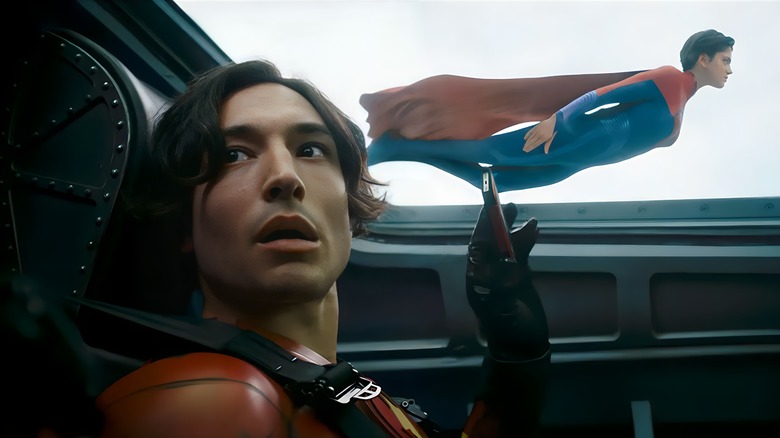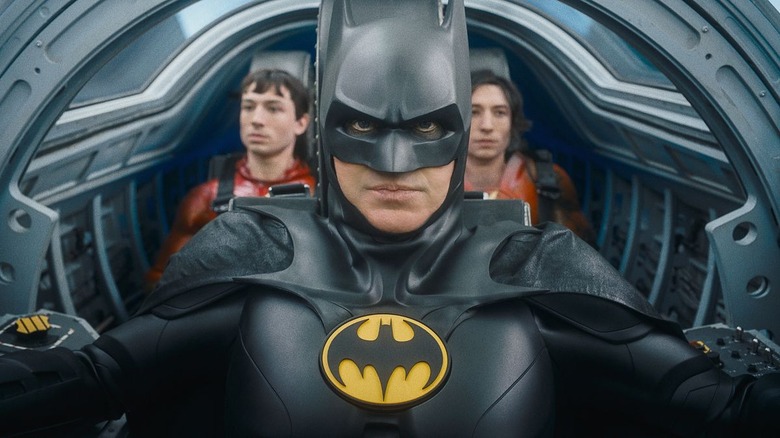The Flash Used Audio From YouTube For Some Of The Big Multiverse Cameos
This article contains spoilers for "The Flash."
The DC Extended Universe era of Warner Bros. and DC Studios' superhero films effectively ends with Andy Muschietti's "The Flash," the film that serves as the reset of the DC Universe. By borrowing from the "Flashpoint" storyline in the comics, "The Flash" is not just a story about the hero, Barry Allen (Ezra Miller), but also about Supergirl (Sasha Calle), General Zod (Michael Shannon), and two different Batmen (Michael Keaton and Ben Affleck). But of course, since we're playing in the sandbox of multiverse storytelling, the superhero cameos extend far beyond the officially announced players.
In a vital moment in "The Flash," Barry Allen moves fast enough to enter the "Chrono Bowl," allowing him to see a flurry of Batmen and Supermen cameos from previous adaptations appearing throughout the multiverse. Playing with multiverses is nothing new, and it certainly didn't help "The Flash" that "Spider-Man: Across the Spider-Verse" debuted in theaters two weeks prior and absolutely ate its multiverse lunch. The cameos have been hotly debated as deceased actors like Christopher Reeve and Adam West were brought back through digital necromancy to appear in the film, adding to the existing PR nightmare surrounding the release thanks to Ezra Miller's off-screen criminal activity.
Regardless of how anyone individually feels about the ethical conundrums surrounding "The Flash," the film was released with Miller in the starring role and the cameos exist in the final cut. While the use of visual effects is a given in order to incorporate footage from the deceased performers to look like they're from the same universe as "The Flash," the audio provided in order to give the characters a voice came from an unlikely source: YouTube.
'It was just a matter of finding out what we were legally allowed to use'
During a recent interview with Screen Rant, supervising sound editor Nancy Nugent explained that much of the audio used for the cameos in "The Flash" came from videos accessible on YouTube, and from what it sounds like, likely user/fan-uploaded footage to boot. As Nugent said:
"I'll tell you the truth; a lot of them were pulled from YouTube. [We were] finding those old clips, and then it was a matter of removing music if there was music tied to it, or just cleaning it up. Because it was such a design-y moment and there was music going on, we could hide a lot of that. Whereas if it was just playing by itself, [it] might require us digging deeper into the archives — if that stuff even existed. Really, it was just a matter of finding out what we were legally allowed to use: which properties, and whose voices, and all of that, and then finding it on the internet and cleaning it up."
The comment about having to remove music tied to the footage is what makes me think some of the clips were uploaded by fans, as copyright strike-avoiding content creators have been underscoring film, TV, and Broadway shows with additional audio tracks to trick the algorithms from easily recognizing bootlegs for over a decade. Hilariously, "The Flash" isn't the only big release of 2023 to use YouTube to help fill in production gaps. Earlier this year, the Apple TV+ film "Tetris" needed a shot from the game "Mike Tyson's Punch-Out!!" on the NES, and did so by repurposing a Let's Play from the popular YouTube channel, Game Grumps.
YouTube has been a vital tool in helping countless people launch their careers, and now as it seems, helping Hollywood complete their biggest would-be blockbusters.

